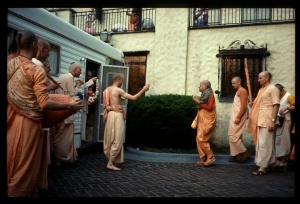CC Madhya 6.13 (1975): Difference between revisions
(Vanibot #0027: CCMirror - Mirror CC's 1996 edition to form a basis for 1975) |
(Vanibot #0020: VersionCompareLinker - added a link to the Version Compare feature) |
||
| Line 2: | Line 2: | ||
<div style="float:left">'''[[Sri Caitanya-caritamrta (1975)|Śrī Caitanya-caritāmṛta (1975)]] - [[CC Madhya (1975)|Madhya-līlā]] - [[CC Madhya 6 (1975)|Chapter 6: The Liberation of Sārvabhauma Bhaṭṭācārya]]'''</div> | <div style="float:left">'''[[Sri Caitanya-caritamrta (1975)|Śrī Caitanya-caritāmṛta (1975)]] - [[CC Madhya (1975)|Madhya-līlā]] - [[CC Madhya 6 (1975)|Chapter 6: The Liberation of Sārvabhauma Bhaṭṭācārya]]'''</div> | ||
<div style="float:right">[[File:Go-previous.png|link=CC Madhya 6.12 (1975)|Madhya-līlā 6.12]] '''[[CC Madhya 6.12 (1975)|Madhya-līlā 6.12]] - [[CC Madhya 6.14 (1975)|Madhya-līlā 6.14]]''' [[File:Go-next.png|link=CC Madhya 6.14 (1975)|Madhya-līlā 6.14]]</div> | <div style="float:right">[[File:Go-previous.png|link=CC Madhya 6.12 (1975)|Madhya-līlā 6.12]] '''[[CC Madhya 6.12 (1975)|Madhya-līlā 6.12]] - [[CC Madhya 6.14 (1975)|Madhya-līlā 6.14]]''' [[File:Go-next.png|link=CC Madhya 6.14 (1975)|Madhya-līlā 6.14]]</div> | ||
{{CompareVersions|CC|Madhya 6.13|CC 1975|CC 1996}} | |||
{{RandomImage}} | {{RandomImage}} | ||
==== TEXT 13 ==== | ==== TEXT 13 ==== | ||
<div class="verse"> | <div class="verse"> | ||
: | :'adhirūḍha bhāva' yāṅra, tāṅra e vikāra | ||
:manuṣyera dehe dekhi, | :manuṣyera dehe dekhi,--baḍa camatkāra | ||
</div> | </div> | ||
| Line 25: | Line 24: | ||
<div class="translation"> | <div class="translation"> | ||
Sārvabhauma Bhaṭṭācārya considered, | Sārvabhauma Bhaṭṭācārya considered, "The uncommon ecstatic symptoms of adhirūḍha-bhāva are appearing in the body of Śrī Caitanya Mahāprabhu. This is very wonderful! How are they possible in the body of a human being?" | ||
</div> | </div> | ||
| Line 32: | Line 31: | ||
<div class="purport"> | <div class="purport"> | ||
Adhirūḍha-bhāva, or adhirūḍha-mahābhāva, is explained in the Ujjvala-nīlamaṇi | Adhirūḍha-bhāva, or adhirūḍha-mahābhāva, is explained in the Ujjvala-nīlamaṇi, by Śrīla Rūpa Gosvāmī. Śrīla Bhaktisiddhānta Sarasvatī Ṭhākura quotes Rūpa Gosvāmī as follows: "The loving propensity of the āśraya (devotee) toward the viṣaya (Lord) becomes so ecstatic that even after enjoying the company of the beloved the devotee feels that his enjoyment is insufficient. At such a time, the lover sees the beloved in different ways. Such a development of ecstasy is called anurāga. When anurāga reaches its highest limit and becomes perceivable in the body, it is called bhāva. When the bodily symptoms are not very distinct, however, the emotional state is still called anurāga, not bhāva. When bhāva ecstasy is intensified, it is called mahā-bhāva. The symptoms of mahā-bhāva are visible only in the bodies of eternal associates like the gopīs." | ||
</div> | </div> | ||
Latest revision as of 18:33, 27 January 2020

A.C. Bhaktivedanta Swami Prabhupada
TEXT 13
- 'adhirūḍha bhāva' yāṅra, tāṅra e vikāra
- manuṣyera dehe dekhi,--baḍa camatkāra
SYNONYMS
adhirūḍha bhāva—an ecstasy technically known as adhirūḍha; yāṅra—of whom; tāṅra—of Him; e—this; vikāra—transformation; manuṣyera—of a human being; dehe—in the body; dekhi—I see; baḍa camatkāra—very wonderful.
TRANSLATION
Sārvabhauma Bhaṭṭācārya considered, "The uncommon ecstatic symptoms of adhirūḍha-bhāva are appearing in the body of Śrī Caitanya Mahāprabhu. This is very wonderful! How are they possible in the body of a human being?"
PURPORT
Adhirūḍha-bhāva, or adhirūḍha-mahābhāva, is explained in the Ujjvala-nīlamaṇi, by Śrīla Rūpa Gosvāmī. Śrīla Bhaktisiddhānta Sarasvatī Ṭhākura quotes Rūpa Gosvāmī as follows: "The loving propensity of the āśraya (devotee) toward the viṣaya (Lord) becomes so ecstatic that even after enjoying the company of the beloved the devotee feels that his enjoyment is insufficient. At such a time, the lover sees the beloved in different ways. Such a development of ecstasy is called anurāga. When anurāga reaches its highest limit and becomes perceivable in the body, it is called bhāva. When the bodily symptoms are not very distinct, however, the emotional state is still called anurāga, not bhāva. When bhāva ecstasy is intensified, it is called mahā-bhāva. The symptoms of mahā-bhāva are visible only in the bodies of eternal associates like the gopīs."